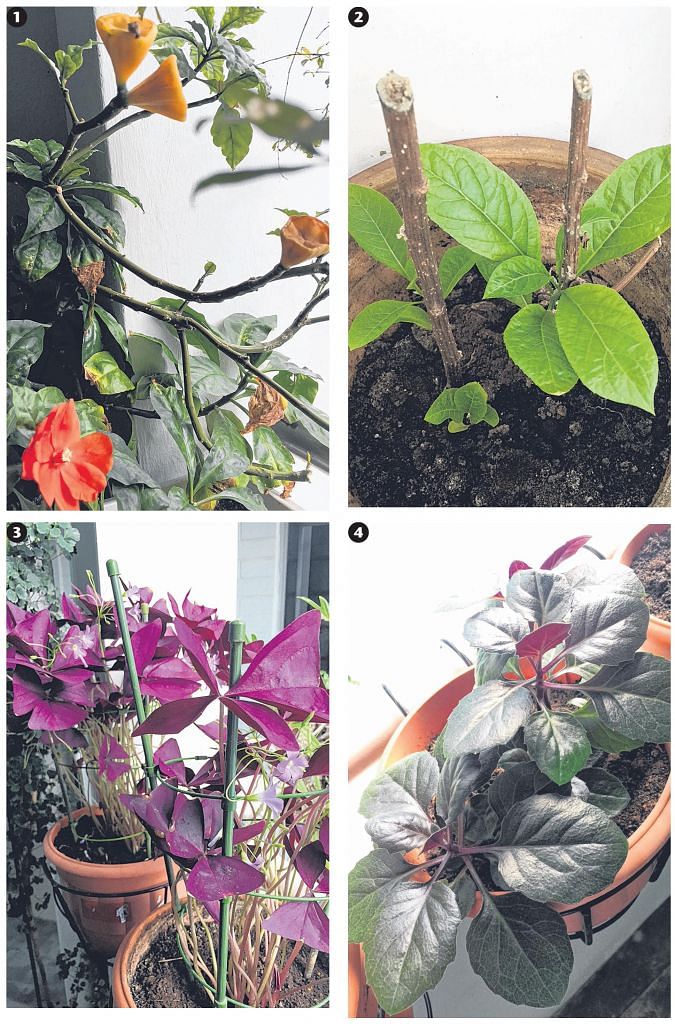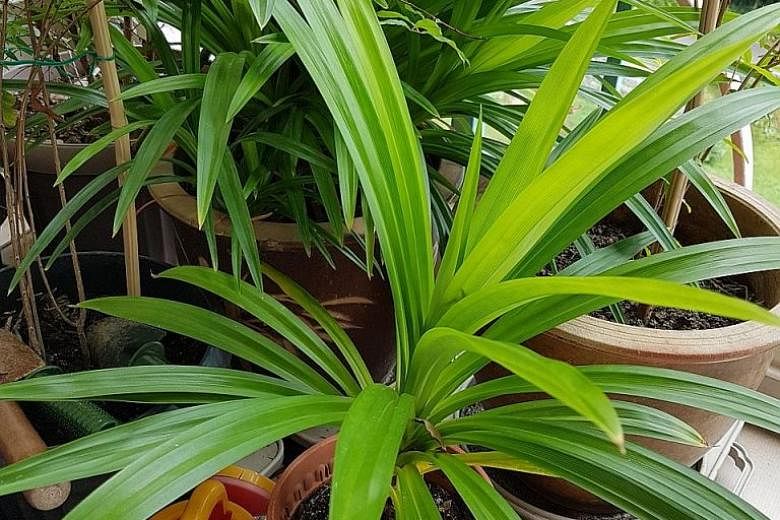Pandan plant may be lacking in sunlight
My pandan plants are on my north-facing balcony, which gets six hours of morning sun for half a year. Their leaves have only a hint of fragrance. I notice that some pandan leaves in the market are very fragrant while others have very little scent. Why is this so? What is the recommended soil media to use for fragrant pandan leaves?
Steven Tan
Although cultivars do matter, the fragrant pandan plant (Pandanus amaryllifolius) generally needs to be grown in a sunny location all year round for its fragrance to develop properly. Rotate your plants periodically to ensure all parts of the plants are exposed to sunlight.
Plant nutrition may be an important requirement for potted plants, where nutrient supply is finite. The leaves of your plants appear to be yellowish and this could point to insufficient nutrients. The plants may also be pot-bound, a situation where the roots have filled the pot.
Pandan is best grown in soil that is moist and fertile, so consider feeding your plants a complete food fertiliser at a dose and frequency recommended on the product label.
Cactus needs four hours of direct sunlight to thrive
What is the name of this plant? Is it an indoor or outdoor plant and will it grow bigger?
Jesse Ngay
The cactus is botanically known as Echinopsis calochlora. As with all cacti, this plant is best grown in a location where it can get at least four hours of direct sunlight daily.
Hence it is not an indoor plant you can grow deep in the house or on a sunless windowsill. Such conditions would not provide sufficient sunlight for the healthy growth of this species.
This species does not seem to grow very big in Singapore - its size is usually about 15cm or less.
Banana plant needs ample light and nutrients
I planted a banana sapling three years ago and it grew into a banana "grove". However, I think there is something wrong with the trees in the grove. Each stem is rather thin and dry and the "covering" of the stems seems to be peeling. Is it because I used compost instead of other fertilisers? Or does the grove have a "disease" unique to banana trees?
Thomas B.S. Tan
Thin banana pseudostems may indicate a lack of vigour in the plants and this could be due to a lack of light and nutrients.
Banana plants are best grown under full sun. Under such conditions, ample water supply is necessary so plants do not suffer from drought stress due to a lack of water.
Also ensure your plant is not growing under shade which can be cast by nearby buildings, trees and other structures.
Banana plants thrive when provided with generous amounts of organic matter and this can come in the form of good quality compost. Compost can also help to retain moisture at the roots.
Feed your plants a fertiliser high in nitrogen and potassium to boost growth.

Quartet of plants have medicinal uses, but consume with care
These plants (left) were given by neighbours and friends. Do they have herbal uses?
Lim Kim Hock
The first plant (photo 1) is the Rose Cactus (Pereskia bleo) and it is commonly known in Singapore as the "Seven Star Needle". Its leaves are harvested and eaten raw and are believed to have anti-cancer properties.
The second plant (photo 2) is probably the Bitterleaf (Vernonia amygdalina). Locals call it the "North Africa Leaf". Its leaves are believed to be able to reduce high blood pressure and high blood sugar.
The plant with purple leaves (photo 3) is known as the Purple Shamrock (Oxalis regnellii "Atropurpurea"). It is often sold as a houseplant for its ornamental foliage. Its young leaves are added raw to salads for colour. They can be eaten and are sour.
The last plant (photo 4) is a species of Gynura. Its leaves are edible and may possess the same blood pressure-lowering effects as other species of Gynura.
All the plants have medicinal properties. It is recommended to consult a physician before using or consuming a plant for medicinal purposes.
Swiss cheese plant needs some light to thrive
My plant looks unhealthy. Is the issue due to overwatering or a lack of light?
Mandy Ho
Your Swiss cheese plant (Monstera deliciosa) could be both lacking in sunlight and suffering from overly wet soil. Such conditions can lead to a weak plant that is susceptible to diseases. In this case, the leaves could have been infected by a fungus.
This plant is often sold as an "indoor plant", but it will do well only if it can get at least four hours of direct or filtered sunlight daily in an apartment and if the leaves do not burn under the given light intensity.
The soilshould be aerated, well-drained and moisture-retentive. It should not remain soggy for overly long periods. If growing conditions do not change, the plant is likely to decline over time.
You should move this plant to a brighter location to recuperate after a period of indoor display.
• Answers by Dr Wilson Wong, a certified practising horticulturist and founder of Green Culture Singapore (www.greenculturesg.com). He is also an NParks-certified park manager.
• Have a gardening query? E-mail it with clear, high-resolution pictures of at least 1MB, if any, and your full name to stlife@sph.com.sg




